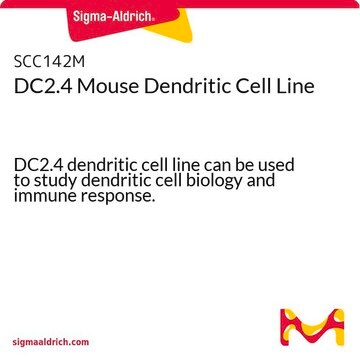SCC134
IMG Mouse Microglial Cell Line
Mouse
Sinónimos:
Immortalized microglial cells
About This Item
Productos recomendados
product name
IMG Mouse Microglial Cell Line, IMG microglial cells recapitulate key features of microglial cell activation and may be used to study neuroinflammatory responses underlying Alzheimer′s disease.
origen biológico
mouse
Nivel de calidad
técnicas
cell based assay: suitable
Condiciones de envío
ambient
Descripción general
Reference:
1. McCarthy RC, Lu DY, Alkhateeb A, Gardeck AM, Lee CH and Wessling-Resnick M (2016). Characterization of a novel adult murine immortalized microglial cell line and its activation by amyloid-beta. J. Neuroinflammation 13: 21
Descripción línea celular
Aplicación
Immune Response
Inflammation & Immunology
Neuroscience
Neurodegenerative Diseases
Neuroinflammation & Pain
Calidad
• Cells are tested negative for infectious diseases by a Mouse Essential CLEAR panel by Charles River Animal Diagnostic Services.
• Cells are verified to be of mouse origin and negative for inter-species contamination from rat, chinese hamster, Golden Syrian hamster, human and non-human primate (NHP) as assessed by a Contamination Clear panel by Charles River Animal Diagnostic Services.
• Cells are negative for mycoplasma contamination.
Almacenamiento y estabilidad
Código de clase de almacenamiento
12 - Non Combustible Liquids
Clase de riesgo para el agua (WGK)
WGK 1
Punto de inflamabilidad (°F)
Not applicable
Punto de inflamabilidad (°C)
Not applicable
Certificados de análisis (COA)
Busque Certificados de análisis (COA) introduciendo el número de lote del producto. Los números de lote se encuentran en la etiqueta del producto después de las palabras «Lot» o «Batch»
¿Ya tiene este producto?
Encuentre la documentación para los productos que ha comprado recientemente en la Biblioteca de documentos.
Nuestro equipo de científicos tiene experiencia en todas las áreas de investigación: Ciencias de la vida, Ciencia de los materiales, Síntesis química, Cromatografía, Analítica y muchas otras.
Póngase en contacto con el Servicio técnico








